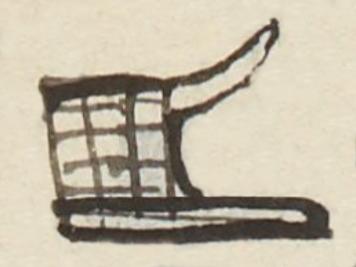Cachua (MH497r)
This black-line drawing of the simplex glyph for the personal name Cachua (pronounced Cac-hua, meaning "Possessor of Shoes" and here attested as a man's name) shows a profile view of an Indigenous sandal/shoe (cactli). It is facing toward the viewer's right. It has a foundation, a woven heel covering, and an ankle strap (which was sometimes long enough to wrap part of the calf). It was usually made of leather, although sometimes the base could be fiber. The -hua suffix, for possession, is not shown visually.
Stephanie Wood
The possession of shoes would carry some status, as it was largely the elite that wore cactli. Sometimes shoes were decorated with metal, gems, or jaguar skins. [See: Barbara A. Somervill, Empire of the Aztecs (2009, 100).] As shown in the examples below, sometimes the back of the sandal was a solid piece of leather, whereas this one is woven. Also, the examples from the Codex Mendoza suggest that the ankle tie was a leather strap dyed red.
Stephanie Wood
Juan
cachua
Juan Cachua
Stephanie Wood
1560
Jeff Haskett-Wood
sandals, shoes, sandalias, cactles, huaraches, nombres de hombres

cac(tli), shoes, https://nahuatl.wired-humanities.org/content/cactli
hua, possession, https://nahuatl.wired-humanities.org/content/hua
posiblemente, Poseedor de Zapatos
Stephanie Wood
Matrícula de Huexotzinco, folio 497r, World Digital Library, https://www.loc.gov/resource/gdcwdl.wdl_15282/?sp=73&st=image
This manuscript is hosted by the Library of Congress and the World Digital Library; used here with the Creative Commons, “Attribution-NonCommercial-ShareAlike 3.0 License” (CC-BY-NC-SAq 3.0).





